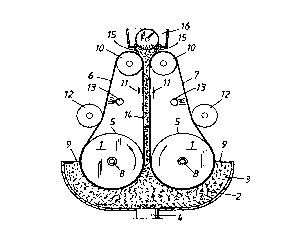Some of the information on this Web page has been provided by external sources. The Government of Canada is not responsible for the accuracy, reliability or currency of the information supplied by external sources. Users wishing to rely upon this information should consult directly with the source of the information. Content provided by external sources is not subject to official languages, privacy and accessibility requirements.
Any discrepancies in the text and image of the Claims and Abstract are due to differing posting times. Text of the Claims and Abstract are posted:
| (12) Patent Application: | (11) CA 2234097 |
|---|---|
| (54) English Title: | A CONCENTRATOR PRESS |
| (54) French Title: | PRESSE A EPAISSIR |
| Status: | Deemed Abandoned and Beyond the Period of Reinstatement - Pending Response to Notice of Disregarded Communication |
| (51) International Patent Classification (IPC): |
|
|---|---|
| (72) Inventors : |
|
| (73) Owners : |
|
| (71) Applicants : |
|
| (74) Agent: | SMART & BIGGAR LP |
| (74) Associate agent: | |
| (45) Issued: | |
| (86) PCT Filing Date: | 1996-10-03 |
| (87) Open to Public Inspection: | 1997-04-17 |
| Availability of licence: | N/A |
| Dedicated to the Public: | N/A |
| (25) Language of filing: | English |
| Patent Cooperation Treaty (PCT): | Yes |
|---|---|
| (86) PCT Filing Number: | PCT/SE1996/001249 |
| (87) International Publication Number: | WO 1997013572 |
| (85) National Entry: | 1998-04-06 |
| (30) Application Priority Data: | ||||||
|---|---|---|---|---|---|---|
|
A concentrator press includes a pair of rotatble press rolls (1) which coact
with one another. The press rolls have apertured or perforated mantle surfaces
(5) for removing liquid from a liquid-drenched material (3) to be concentrated
and advanced between the press rolls. A part of the peripheral surface (5) of
each press roll (1), including at least those regions in which the press roll
acts on material undergoing concentration, is surrounded by a respective
endless filter-cloth web (6, 7) which also runs around at least one direction
changing roller (10; 10, 17, 18) at a distance from its associated press roll
(1) and the still not concentrated, liquid-drenched material (3). The filter-
cloth webs (6, 7) extend generally parallel with each other downstream of the
press nip, to a concentrated material delivery station (15, 16).
La présente invention concerne une presse à épaissir qui comprend deux rouleaux de presse rotatifs (1), qui coopèrent l'un avec l'autre. Leurs surfaces d'enveloppe (5) présentent des ouvertures ou des perforations pour éliminer le liquide d'une matière qui en est saturée (3) et qui doit être concentrée et déplacée vers l'avant entre les rouleaux de presse. Chacun de ces rouleaux (1) est entouré sur une partie de sa surface périphérique (5), y compris au moins au niveau des zones dans lesquelles il agit sur la matière en cours de concentration, par une bande sans fin de tissu filtrant (6, 7), qui passe aussi autour d'au moins un rouleau de renvoi (10; 10, 17, 18) situé à une certaine distance du rouleau de presse qui lui correspond (1) et de la matière trempée, non encore concentrée (3). Les bandes de tissu filtrant (6, 7) sont sensiblement parallèles en aval de la zone de pression, jusqu'à un poste de livraison (15, 16) de la matière concentrée.
Note: Claims are shown in the official language in which they were submitted.
Note: Descriptions are shown in the official language in which they were submitted.

2024-08-01:As part of the Next Generation Patents (NGP) transition, the Canadian Patents Database (CPD) now contains a more detailed Event History, which replicates the Event Log of our new back-office solution.
Please note that "Inactive:" events refers to events no longer in use in our new back-office solution.
For a clearer understanding of the status of the application/patent presented on this page, the site Disclaimer , as well as the definitions for Patent , Event History , Maintenance Fee and Payment History should be consulted.
| Description | Date |
|---|---|
| Inactive: IPC from MCD | 2006-03-12 |
| Time Limit for Reversal Expired | 2000-10-03 |
| Application Not Reinstated by Deadline | 2000-10-03 |
| Deemed Abandoned - Failure to Respond to Maintenance Fee Notice | 1999-10-04 |
| Inactive: First IPC assigned | 1998-07-13 |
| Inactive: IPC assigned | 1998-07-13 |
| Classification Modified | 1998-07-13 |
| Inactive: IPC assigned | 1998-07-13 |
| Inactive: IPC assigned | 1998-07-13 |
| Inactive: Notice - National entry - No RFE | 1998-06-16 |
| Application Received - PCT | 1998-06-15 |
| Application Published (Open to Public Inspection) | 1997-04-17 |
| Abandonment Date | Reason | Reinstatement Date |
|---|---|---|
| 1999-10-04 |
The last payment was received on 1998-04-06
Note : If the full payment has not been received on or before the date indicated, a further fee may be required which may be one of the following
Please refer to the CIPO Patent Fees web page to see all current fee amounts.
| Fee Type | Anniversary Year | Due Date | Paid Date |
|---|---|---|---|
| Basic national fee - standard | 1998-04-06 | ||
| MF (application, 2nd anniv.) - standard | 02 | 1998-10-05 | 1998-04-06 |
| Registration of a document | 1998-04-23 |
Note: Records showing the ownership history in alphabetical order.
| Current Owners on Record |
|---|
| SUNDS DEFIBRATOR INDUSTRIES AB |
| Past Owners on Record |
|---|
| EBBE HODEN |